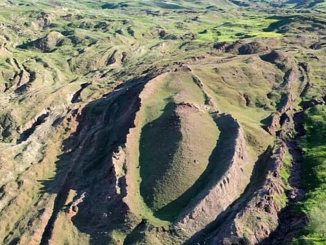
The discoveries were made by an American research team working at Durupinar Formation (Image: NoahsArkScans.com)
Archaeologists have made a stunning discovery using radar technology to locate what they believe are remnants of Noah’s ark in Turkey. Ground Penetrating Radar (GPR) analysis has revealed a “chemical imprint” along with “pieces of wood in the ground” and “the shape of a hall.”
[snip]
Independent researcher Andrew Jones from Noah’s Ark Scans employed ground-penetrating radar to detect what appeared to be a 13-foot passageway cutting through the formation’s center. Archaeologists were also blown away by a ‘humna’ discoveyr which holds the key to Noah’s Ark evidence
The team’s GPR data analysis claims to have identified central and side passages or corridors throughout the vessel. The scans additionally detected three distinct layers underground, corresponding with the Biblical description of the ark containing three levels.
[snip]

Speaking to The Christian Broadcasting Network (CBN), researcher Andrew explained: “We’re not expecting something that’s fully preserved. What’s left is the chemical imprint, pieces of wood and in the ground, the shape of a hall.”
[snip]
Scripture states that Noah’s Ark came to rest on the “mountains of Ararat” after a devastating 150-day deluge that destroyed all life not housed inside the wooden vessel. The formation lies close to a mountain whose summit shows a remarkable similarity to the ark’s recorded shape and size.

A new analysis of the team’s GPR data purports to have found central and side corridors or hallways running through the boat (Image: NoahsArkScans.com)
Biblical texts describe the ark as “300 cubits long, 50 cubits wide, and 30 cubits high”- roughly 515 feet long, 86 feet wide, and 52 feet tall. The hypothesis that the ark settled on Mount Ararat has sparked heated discussion for decades.
[snip]
During a recent conversation with CBN News, Andrew revealed new information about the scans he and his group of independent investigators have been performing over the last several years at the Durupınar Formation. To date, the scans have revealed angular formations as deep as 20 feet below the surface-characteristics that might indicate chambers beneath a deck-like structure.
In Genesis 6:14, the Bible describes the ark: “Make thee an ark of gopher wood; rooms shalt thou make in the ark, and shalt pitch it within and without with pitch. ” Andrew pointed out: “This is not what you’d expect to see if the site were simply a solid block of rock or the result of random mudflow debris.
“But it is exactly what you’d expect to find if this were a man-made boat, consistent with the biblical specifications of Noah’s Ark.”
The team has also carried out soil testing, discovering what Andrew described as “some interesting things.”
[snip]
He also discussed their soil analysis, noting that organic matter was found to be twice as high inside the formation compared to the surrounding soil. “The potassium levels inside are also about 40 percent higher,” William said.
He added: “If you know soil science-as I’m a soil scientist-you’ll understand that potassium levels, organic matter, and pH can all be influenced by decaying organic material. If this was a wooden boat and the wood had rotted over time, we would expect to see elevated levels of potassium, changes in pH, and higher organic content-and that’s exactly what we’re finding.”
[snip]
“We want to compare what’s inside the formation to what’s outside,” Andrew stated. “That could give us a much clearer picture of whether this is truly something man-made.
* Original Article:
https://www.the-express.com/news/world-news/190115/archaeologists-find-noah-s-ark-incredible-new-discovery
